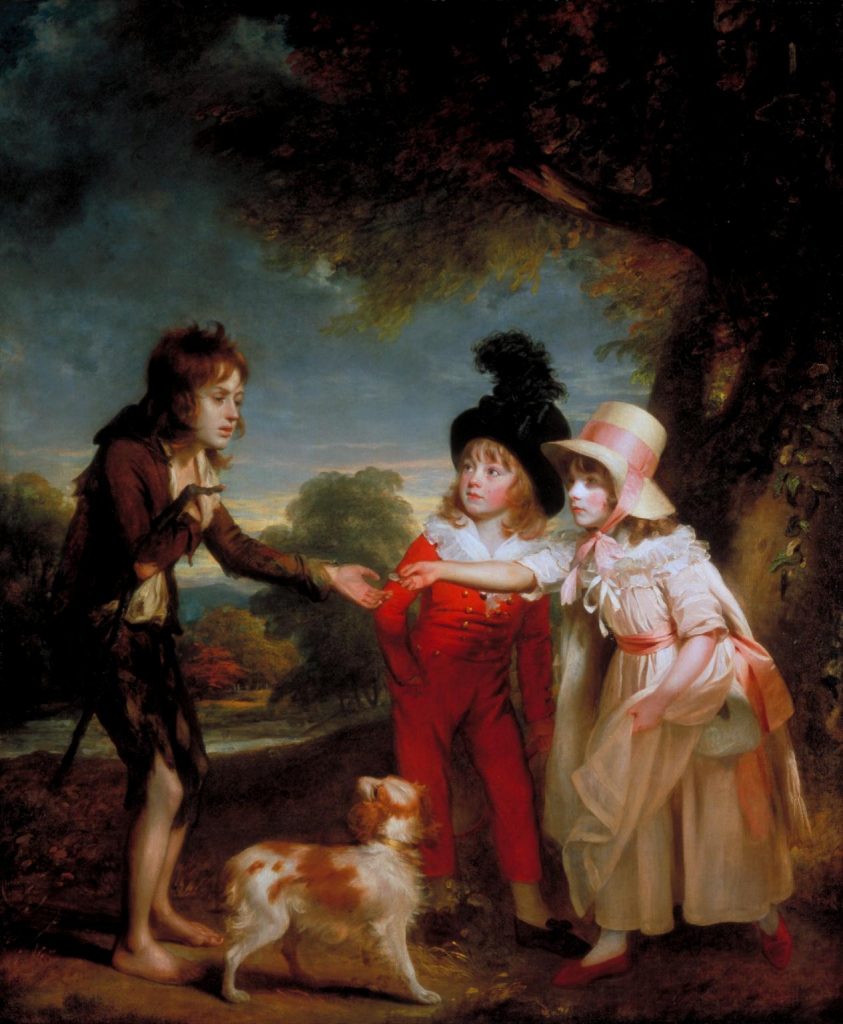
Sir William Beechey (1753-1839), Portrait of Sir Francis Ford’s Children Giving a Coin to a Beggar Boy, exhibited 1793
The 1790s were a time when society and the arts debated the relative merits of good sense and reason as opposed to sensibility. ‘Sensibility’ was a heightened awareness of beauty and deep feelings. Jane Austen’s Sense and Sensibility was published in 1811 and was set in the same decade as this painting. We see this heightened sense of feeling takes the form of a fashionably dressed girl and her brother handing a coin to a hunched over beggar. Such emotional scenes of charity had become fashionable at this time but there might be another justification for this scene.
Pro-Slavery Propaganda?
The artist, William Beechey, did not identify the children when he exhibited the work but they were recognised by Horace Walpole, son of the first British prime Minister, Robert Walpole. They are Francis Ford and his sister Mary, the children of Sir Francis Ford, who owned a sugar plantation in Barbados and a property in Ember Court, Thames Ditton, Surrey.
While William Wilberforce was fighting to stop the British slave trade there were many wealthy plantation owners, like Ford, who were arguing that their slaves enjoyed a better quality of life than the poor in England. It is possible therefore that he commissioned this painting not just to show the refinement and sensibility of his children but as pro-slavery propaganda, to show how his family cared for both the poor in England and his slaves in Barbados. Although not connected, Ford fell ill the year this painting was exhibited and died in 1801 after eight years of suffering from ‘a severe and painful illness’.
Finally, following a twenty-year campaign for abolition Parliament passed the Slave Trade Act in 1807. Many believed this would end slavery but it only slowed the trade and slavery continued for a further twenty-six years. The Royal Navy enforced the ban on the slave trade and between 1808 and 1860 they seized approximately 1,600 slave ships and freed 150,000 Africans who were aboard.
William Beechey
William Beechey was a sound artist known for his lack of extravagance which appealed to those like King George III, who regarded other artists, such as Thomas Lawrence, as too flamboyant and ‘eccentric’. When this painting was exhibited the well-known portrait painters Thomas Gainsborough and his rival Sir Joshua Reynolds had both died and the year was a turning point in Beechey’s life and career. He painted a full-length portrait of Queen Charlotte who appointed him her official portrait painter and he was elected an associate of the Royal Academy. He went on to paint not only the royal family but most of the famous and fashionable of the period. The up-and-coming portrait painter was Thomas Lawrence who also painted Queen Charlotte but she did not like the picture. Lawrence’s flamboyant approach appealed to many including the Prince Regent but Beechey remained the favourite of George III and Queen Charlotte while Lawrence went on to become the leading portrait artist of the period.
